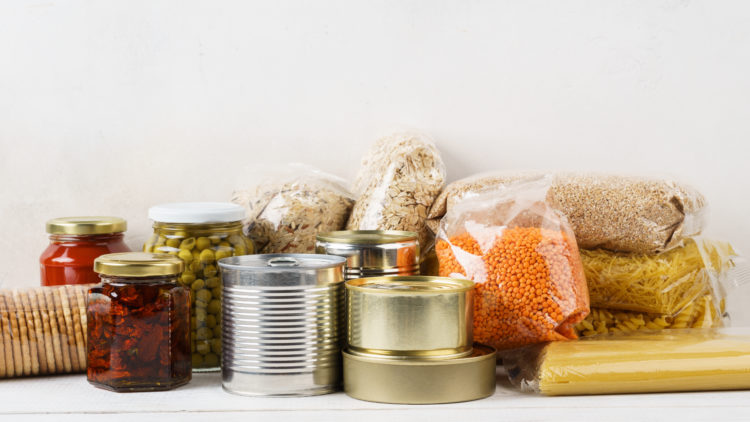
With talk of food shortages, I wanted to remind everyone about our store cupboard. They could have gems you’ve probably forgotten about that would make a delicious and nutritious meal. This is not a new idea, but one that often gets overlooked when talking about food and health. Many of the items we keep in our store cupboard and freezer have lots of benefits to our health. There’s plenty of inspiration to be found far and wide. Food authors like Jack Monroe (cooking on a bootstrap) have been creating simple budget meals with store cupboard ingredients for years. Her cookbooks and blogs are full of good ideas to keep costs low and make use of as much as you can.
There is a perception that fresh is always best. But sometimes (like now) when times are tough, or getting out and about isn’t possible it’s not always an option.
Keep things simple and make the most of your freezer and store cupboard with a few of these suggestions;
Freezer and Store Cupboard
Frozen fruit and veg is just as good
When we are eating seasonably our favourite fruit and vegetables are not always available. Freezing some fruit and veg and putting it away for a rainy day means that you can have access to your seasonal favourites all year round. Additionally, there’s a preconception that freezing fruit and vegetables makes them less nutritious than eating them fresh, but in many cases, this is untrue (1). As soon as vegetables are harvested they start to lose some nutrients, particularly vitamin C (2). This is one reason why choosing frozen vegetables can be a great solution, as vegetables are frozen when still fresh, usually within a few hours of harvesting. Interestingly some other nutrients may even be more available after freezing, such as lipid-soluble Vitamins A and E (3). Freezing fruit and vegetables is an affordable, practical, convenient solution, and great to have in the freezer when times are tough.
Freezing meals
Cooking in bulk and popping some in the freezer for later is a great way to save time and to reduce food waste. Also, if you’ve got some leftovers you’re not sure what to do with, pop them in the freezer so you can come back to them. If you’re feeling unwell, stressed or anxious having a few meals in the freezer is a great way to see you through.
Tins
Tinned food is probably not your go-to when thinking about what constitutes ‘healthy’. But they are really convenient when you can’t get out to buy fresh veg or when you need something quickly.
Nutritionally speaking, the preservation method means that tinned vegetables have a long shelf-life. They are a great solution when you can’t get to the shops, or are running low on fresh fruit and veg. In terms of their vitamin and mineral loses they are similar to cooked vegetables. Compared to freezing when fresh, more nutrients are lost. However, this is not always the case. For example, changes in fibre and mineral content appear to be stable during processing. Unless, in the case of fibre the product has had peel or outer layers removed (3).
Canned fish
Oily fish such as sardines and salmon can be cheaper than buying the fresh versions, as with anything canned they also have a longer shelf-life. These types of fish are high in omega -3 fats which are long chain fats. They are important for our heart health, and there is some evidence to suggest they are also beneficial for our brain health.
Fish is also a good source of protein that is lower in fat than red or processed meat. They also contain what’s considered ‘high-quality’ protein as it contains all of our essential amino acids. Protein rich foods are an important part of our diet as we are consistently using proteins in key functions in the body. When picking a canned variety, the spring water versions tend to be lower in salt, which makes a slightly healthier choice.
Back to basics
The dry food in your store cupboard may not always seem like the most exciting part of a meal, but rice, pasta, noodles and grains are essential to so many dishes. Additionally, these staple foods can provide us with lots of good nutrition. They are a source of carbohydrates, which is our bodies preferred energy source, and provide us with energy throughout the day. For example, oats are high in a type of soluble fibre called beta-glucans, which contribute to the maintenance of normal cholesterol levels. Not only that but they are also a source of a fair few vitamins including iron, folic acid and magnesium. Use them to make a variety of breakfasts like porridge or overnight oats, in your baking, blended into a smoothie or to bulk our dishes. Oats can also be blended to make oat flour which can be used as an alternative to regular flour in baking.
Beans in a tin like butter beans, kidney beans, black beans, chickpeas etc. are really versatile and can be added to lots of dishes. Chickpeas can be used in many different ways. Some examples include; added into curries, salads, soups, stews, blended to make hummus, roasted and added to wraps. Or use as your base to make vegetarian burgers or falafels. The leftover water from a can of chickpeas, known as aquafaba, is viscous and can mimic the functional properties of eggs. So, if you’re a vegan or don’t have any eggs in, it can be used as an egg replacer in meringues, creams, mayonnaise and some bakes.
Additionally, there are lots of health benefits to using beans and pulses. One portion (around 3 tbsp, or 80g) makes one of your five a day, they are good sources of plant-based protein and high in fibre. Here are some examples;
- Chickpeas – High in manganese which is important for our bone health and to protect cells from oxidative stress.
- Kidney Beans – a source of thiamine which is important for normal functioning of the nervous system. As well as a source of phosphorus which works with calcium to maintain healthy bone structure.
- Black Beans – high in folic acid, source of potassium, phosphorus, copper and manganese
- Lentils (red, green & brown) – source of vitamin B6, potassium, phosphorus, iron, copper, manganese and selenium.
- Baked Beans – bear with me with this one, but bake beans bring a lot to the table. As well as the being high in fibre and a source of protein they low in fat and low saturated fat. They also contain a range of micronutrients.
Make use of your leftovers
At bartlett mitchell we are passionate about reducing food waste and making full use of everything. This can be challenging sometimes but these are a few things you can do at home.
- Use leftover vegetables or slightly passed their best – add them to soups. Use over-ripe fruits in smoothies, juices or desserts.
- When bread starts to go a bit crusty, use it to make breadcrumbs. These can be used on the day, or frozen and used later.
- Ferment, pickle and preserve, so you can use at a later date. This is especially useful if you’ve got fruit and veg that’s going over.
- Use as much as you can, from the bones to the skin of fish and meats, to the stalks and peelings of vegetables. This includes the stalks of broccoli, the leaves of cauliflowers and the skins of citrus fruits. Use the veg to make an amazing stock and grate the rinds and blitz them to make deliciously flavoured home-made biscuits.
- Additionally, there are a multitude of wonderful charities operating all over the UK that you can donate food to if you have too much. There are also lots of apps that now make donating food easier. Olio (4) helps you to connect to your neighbours and local businesses so that any surplus food can be shared.
References;
- Li L, Pegg R, Eitenmiller R, Chun J, Kerrihard A. Selected nutrient analyses of fresh, fresh-stored, and frozen fruits and vegetables. Journal of Food Composition and Analysis. 2017;59:8-17.
- Rickman J, Barrett D, Bruhn C. Nutritional comparison of fresh, frozen and canned fruits and vegetables. Part 1. Vitamins C and B and phenolic compounds. Journal of the Science of Food and Agriculture. 2007;87(6):930-944.
- Rickman J, Bruhn C, Barrett D. Nutritional comparison of fresh, frozen, and canned fruits and vegetables II. Vitamin A and carotenoids, vitamin E, minerals and fiber. Journal of the Science of Food and Agriculture. 2007;87(7):1185-1196.
- OLIO – Share more. Waste less. OLIO. Available from: https://olioex.com/
